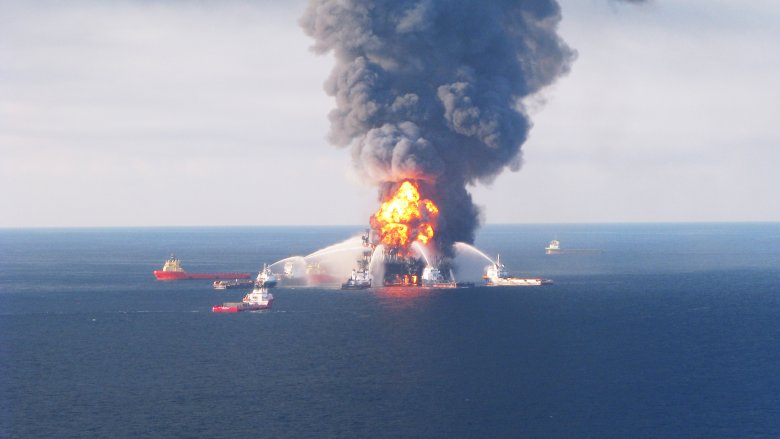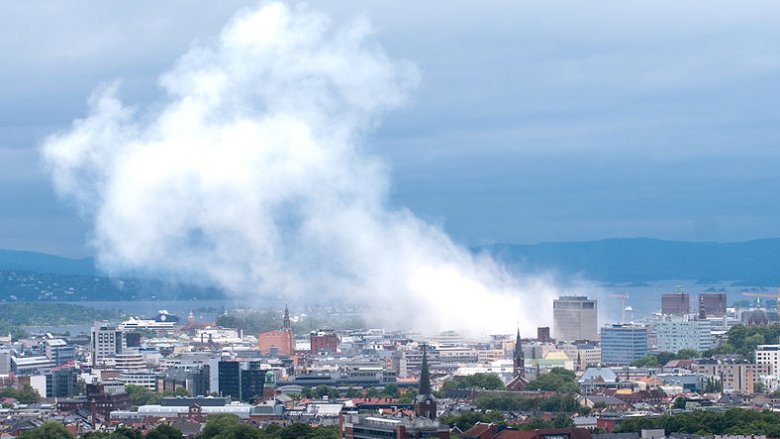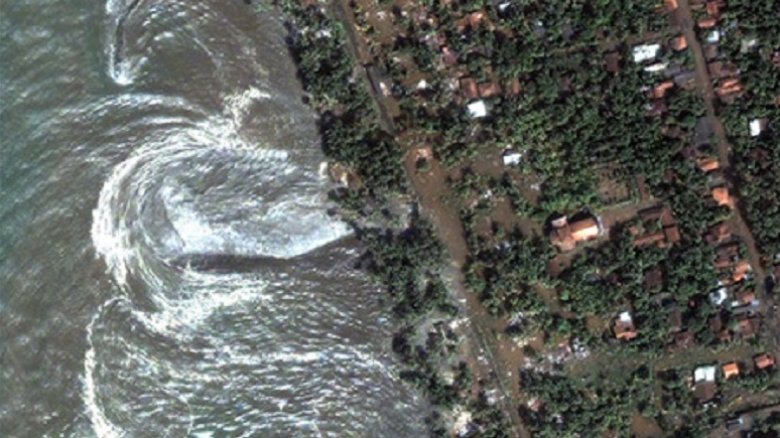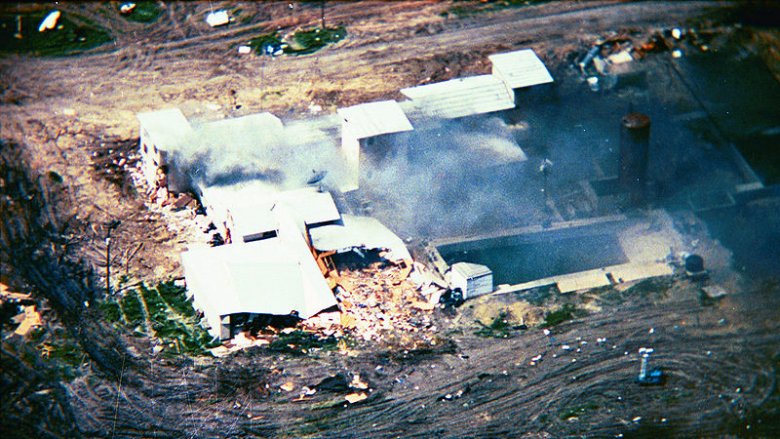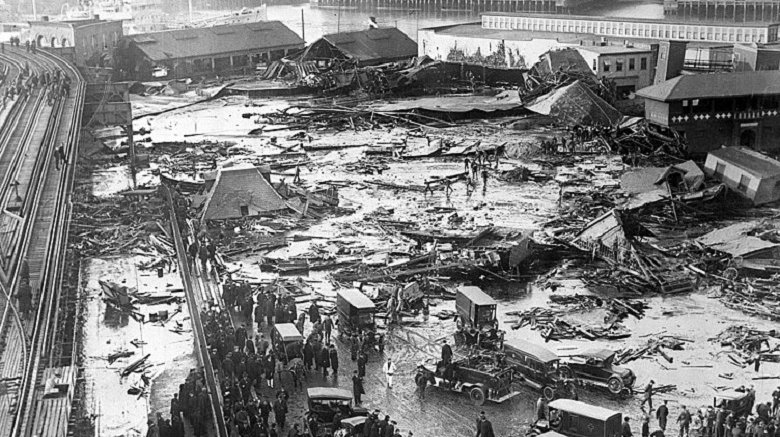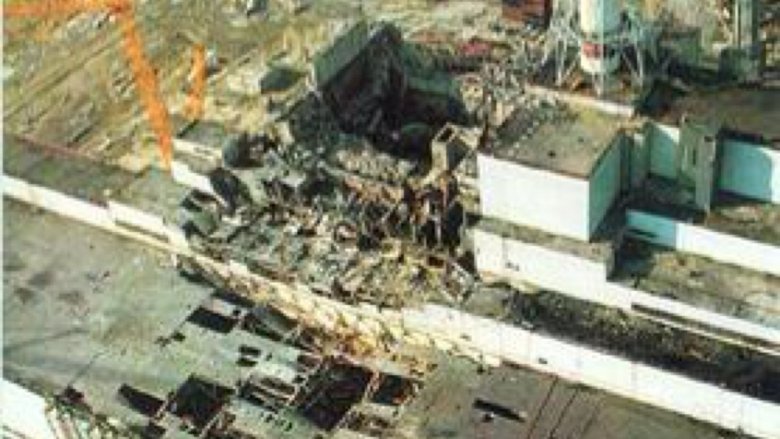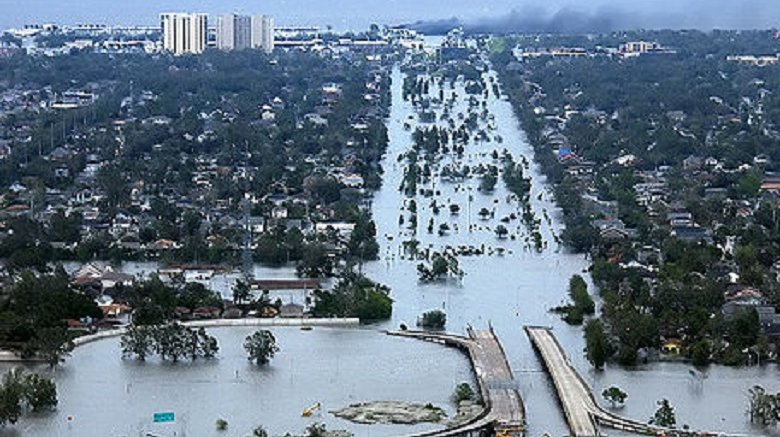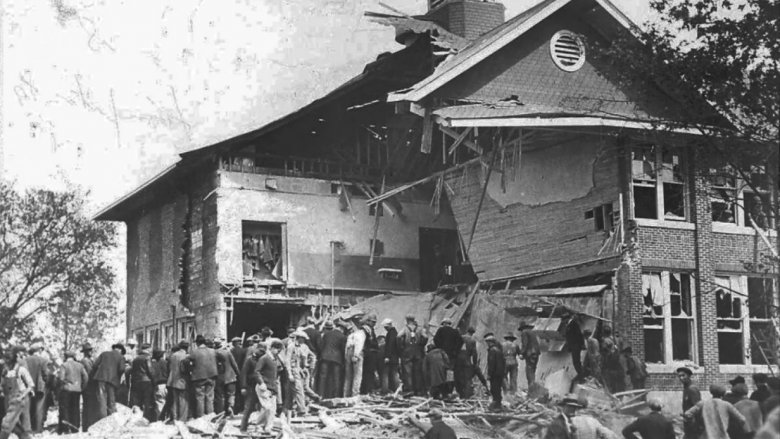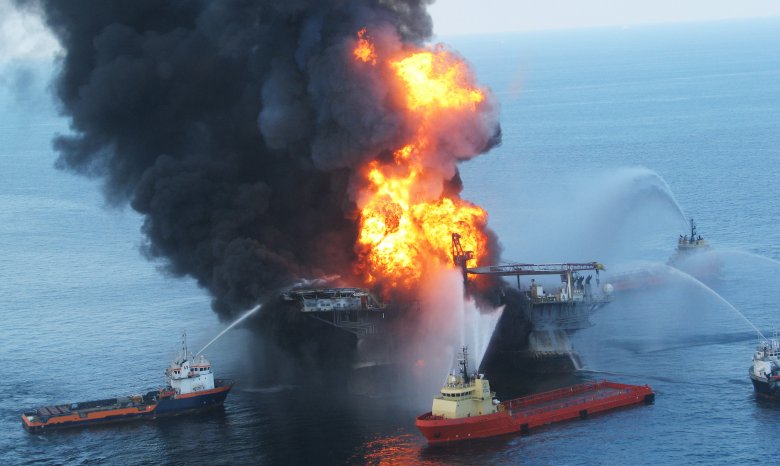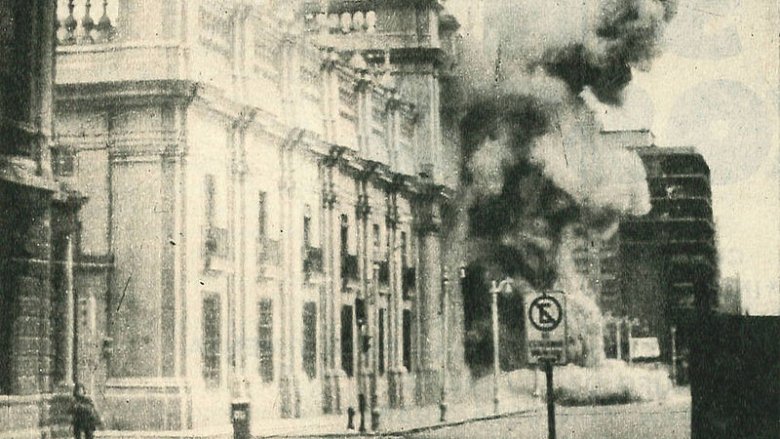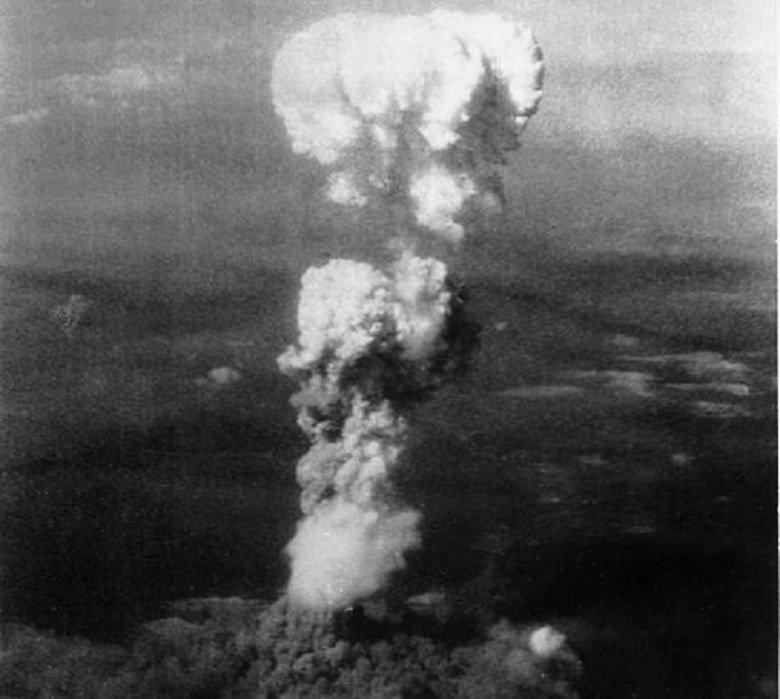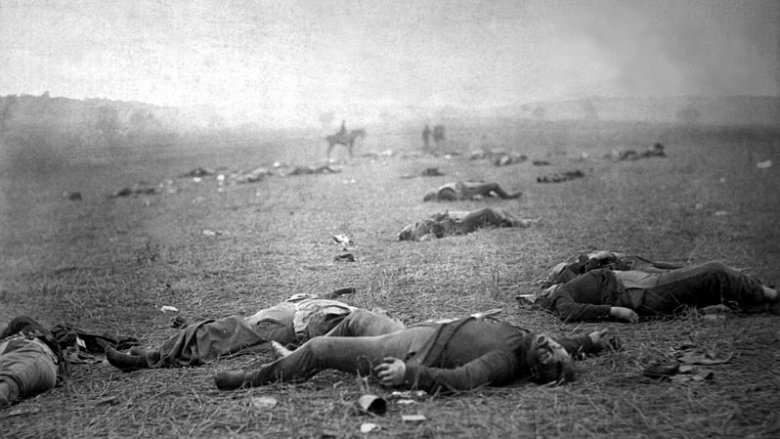Chilling Photos Showing Moments Right After Terrifying Events
There's an old adage that goes "comedy is tragedy plus time." Whoever said that must've been speaking before the invention of the portable camera. While it's not so hard to imagine a comedy based around Vikings pillaging their way across northern Europe — if only thanks to the silly, anachronistic hats — it's less easy to imagine someone making a comedy about the effects of, say, Agent Orange. Or the Oklahoma City bombing. Or the 1919 Armenian genocide. Being able to access images of those disasters at the push of a button somehow makes them much more real.
That's especially the case when the images are particularly powerful, or poignant, or just straight-up terrifying. Mathematicians often point out that the average picture is worth a thousand words. In that case, the following pictures must be worth a series of freakishly disturbing novels. Everything you're about to see is totally safe for work, and features no gore or traumatized people. It's only when you really think about the implications of these pictures that you realize how chilling these photos are.
Oslo's skyline on the day of the 2011 attacks
It was a warm afternoon in the Norwegian capital Oslo when the van exploded in the government quarter (the Regjeringskvartalet), sending debris flying. The car bomb had been placed right outside the block housing the prime minister's office, within spitting distance of the Supreme Court. It was built in the same fashion as the 1995 Oklahoma City bomb, but, luckily, was far less successful. Eight people were killed in the blast, and some 200 injured (via BBC). Far less luckily, Oslo's day of terror wasn't over. The bomber, Anders Breivik, was already on his way to nearby Utoya Island, where he would gun down 69 teenagers at a summer camp.
The picture above was taken between the two massacres, roughly 30 minutes after the car bomb went off, and about an hour before the shooting started on Utoya Island. It was uploaded to Wikimedia Commons by a private user identified only as N. Andersen. Whoever Mr. Andersen is, his photo captures the enormity of what had just hit Norway. The plume of smoke dwarfs every building in Oslo, casting a literal and figurative shadow over the city. Perhaps the worst part of looking at this photo? Knowing the worst was yet to come.
By the time the dust in this photo had settled, Norway had experienced its worst massacre since the end of World War II. Anders Breivik would eventually be sentenced to 21 years, with the possibility of indefinite extensions, the maximum allowed under Norwegian law (via The Guardian).
The aftermath of the Indian Ocean tsunami
The day after Christmas Day 2004 was one of the deadliest days in history. That's not "modern history." That's history, full stop. That morning, a huge earthquake ripped up the seabed of the Indian Ocean, unleashing more pent-up energy than a sackful of Krakatoas. But it wasn't the quake that was the real issue — it was what followed. As Encyclopedia Britannica recounts, the upheaval set off a cluster bomb of tsunamis that pounded every shore on the Indian Ocean for the next seven hours. By sundown, nearly 250,000 people were dead.
By some counts (such as this one by Live Science) this makes the 2004 tsunami one of the 10 deadliest natural disasters to ever afflict humanity. Countries as far away as Somalia, Tanzania, and Yemen were hit by damaging or deadly waves. The worst, though, was reserved for India, Indonesia, and Sri Lanka. None of those countries recorded death tolls below 10,000. In Indonesia and Sri Lanka, it was much, much higher.
The photo above was taken by satellite the day of the tsunami, after the waves had pounded into Sri Lanka, killing over 30,000. On NASA's website, you can see the same stretch of coast before the disaster. If you take a look, it becomes clear the entire beachfront is just ... gone. There's nothing left of that road and those houses but roiling, angry waves.
The ruined compound at Waco
Maybe you only know the Waco siege as something your gun-lovin' uncle likes to rant about whenever someone mentions the gubmint. Had you been old enough to follow the news in 1993, it would be burned into your mind, too. At the end of that February, federal agents raided the Branch Davidian compound at Waco, where 130 cultists lived. The Branch Davidians were a Christian sect whose leader, David Koresh, liked to combine the Bible with weaponry, polygamy, and child abuse (via Time). When the ATF went to arrest him, they triggered a shootout that left four ATF agents and six Davidians dead.
The FBI took over the case and surrounded the compound. And so started one of the craziest sieges in American history. It lasted 51 days and involved Koresh reading a message on national radio, the FBI blasting Nancy Sinatra songs full volume into the compound (via EW), and Koresh deciding he was the Second Coming. At the climax of it all, someone started a fire and the entire compound went up in flames, killing 76 Davidians, including David Koresh.
The image above is of the Branch Davidian compound moments after the fire broke out, before the flames consumed the building. It's a chilling photo not just for what it shows, but for what it portends. Miles away, Timothy McVeigh was watching the exact same thing happen on TV. He later claimed the 1995 Oklahoma City bombing was revenge for what he saw that day (via NBC).
The aftermath of the Boston molasses disaster
Death generally comes as a surprise. But there are surprises like "Whoops, shoulda checked for that bus," and then there are surprises like "Is that a 25-foot wave of killer molasses?!" If you were unlucky enough to be wandering Boston's North End on January 15, 1919, those words might well have been the last you ever said. That was the day a 2.3-million-gallon vat of molasses exploded, sending a black tidal wave rolling down Commercial Street. Twenty-one people were drowned, 150 injured, and whole rows of houses completely swept away (via The Atlantic).
Thanks to the fact that the killer wave was made from molasses, the disaster sounds almost whimsical, like something from a kids' film. It's not until you see a photo like the one above that you realize how destructive this disaster really was. According to the Smithsonian, the wave traveled at 35 mph, a speed at which even water does serious damage, let alone a heavy, viscous fluid like molasses.
Oddly enough, this ain't the only unlikely killer flood on record. About a century before Boston vanished beneath molasses, a flood of beer killed eight people in similar circumstances in London. Even weirder, about a century after the Boston disaster, another molasses flood hit Honolulu. Thankfully, this time it poured straight into the ocean without killing anyone.
The remains of Chernobyl's Reactor 4
Among other things, the Chernobyl disaster is a reminder that God has a finely tuned sense of irony. Just after midnight on April 26, 1986, Soviet engineers decided to carry out a safety test on Reactor 4 at the Chernobyl nuclear power plant. Their test immediately led to a not-very-safe nuclear explosion, followed by a fire and meltdown that lasted for 10 whole days (via Time). Twenty years later, the U.N.'s scientific committee on the effects of atomic radiation (UNSCEAR) would take stock of the damage. They recorded 30 dead workers, 100 injured, over 300,000 people displaced, and 6,000 children with radiation-caused thyroid cancer. If you're reading this, Alanis, that is how you correctly define irony.
That gaping hole you can see in the picture is all that remained of Reactor 4 after it blew its top. Taken by someone working for Soviet authorities, it shows exactly how destructive shoddy Communist construction plus safety tests can be. This is after the fire was put out, remember. The first rescue workers saw that image, plus a billowing cloud of deadly smoke that could strip the flesh from their bones.
Speaking of shoddy Communist construction, the concrete "sarcophagus" built around the ruin to contain radiation was only designed to last 30 years. In 2016, 30 countries had to pony up $1.2 billion to build a new tomb that would last a century, as recorded in a fascinating PBS/BBC documentary.
New Orleans underwater
The average elevation of New Orleans is 6 feet below sea level. In the aftermath of Hurricane Katrina, that sentence became terrifyingly literal. In 2005, 80 percent of Louisiana's biggest city vanished beneath the waters, with the tide rising so high in some places that people had to take shelter on their roofs. As History recounts, the storm surge triggered by Katrina was so powerful the levees surrounding the city crumpled like a wall made of wet tissue. Lake Pontchartrain, Lake Borgne, and about a gazillion different swamps all relocated downtown, and New Orleans quickly found itself looking like a less well-governed version of Waterworld.
The photo above was taken the day the levees broke, August 29. It was the work of a member of the U.S. Coast Guard and shows West End Boulevard, now little more than an extension of Lake Pontchartrain. If you need a "before" comparison point, simply imagine that picture without all the water, and without the creepy knowledge that people were trapped in those very houses in the background there, fighting for their lives as the city disintegrated around them.
The impact of Katrina on New Orleans was so bad that, according to FiveThirtyEight, we still don't know how many died. The lowest number of deaths estimated is around 900, while the highest is over 4,000. Too many bodies simply got washed away or couldn't be documented in the damaged city. There's a sobering thought.
The aftermath of the Bath school bombing
Yep, that's a school you're looking at there — a school about half reduced to rubble, and a whole bunch of worried adults picking through it, wondering if they're ever gonna see their kids again. (This truly chilling account published the year of the disaster talks about body parts of children being found in the rubble by parents.) So what caused this tragedy? A gas explosion? Actually, it was a monumental jerkwad named Andrew Kehoe. As the Smithsonian recounts, in 1927 Kehoe intentionally bombed the school, killing 44.
It was May 18, the last day before summer break. About 314 students from the surrounding hamlets were crammed into the building, unaware that Kehoe, in his capacity as school board treasurer, had visited the night before, and they were now sitting atop 500 pounds of dynamite. Just before 9 a.m., the dynamite exploded, flattening the school's north wing. Moments later, as people rushed to help, Kehoe drove up in a dynamite-filled truck and suicide-bombed the rescuers. And when police raided Kehoe's property, they found his wife murdered.
Despite being the worst school massacre in U.S. history (as bad as the Sandy Hook and Parkland massacres combined), the Bath disaster was almost even worse. Kehoe had planted another 500 pounds of dynamite in the school basement that failed to explode. Chilling as this photo is, there's another parallel-universe version out there where there's nothing left standing of Bath school at all.
Deepwater Horizon burning after the blast
Deepwater Horizon is what happens when you take some of the greatest experts in the field of oil drilling, and stick them in a gung-ho, cost-cutting culture where safety is second to dangerously pushing the envelope. In this case, the envelope was a button marked "Danger: Might explode," and explode is exactly what the floating rig did on April 20, 2010, when a surge of highly flammable gas came roaring up the pipe and did what flammable gas tends to do. As Slate explains, the resulting fireball killed 11 workers and unleashed the worst oil spill in U.S. history.
You've probably heard about the Exxon Valdez spill of 1989. That tanker dumped 11 million gallons of oil into the ocean. Deepwater Horizon expelled north of 200 million (via New York Times). Now we can look back on the photo above and know a sort of justice would be done. Per The Guardian, BP was eventually forced to pay out $65 billion in compensation over the spill, with cement makers Haliburton shouldering an additional $1.1 billion in costs. But money can only fix so many problems, and we can also imagine what it must have been like to be there when this photo was taken, with the scope still unknown.
When Exxon Valdez ran aground, it had a finite amount of oil onboard. Deepwater Horizon's supply was effectively infinite. This was an open wound in the ocean floor through which oil was gushing, and could have continued to gush for years to come.
A missile hitting Chile's presidential palace
September 11, 1973: That's the day residents of the Chilean capital, Santiago, awoke to tanks rolling along the streets and the declaration of a coup. Salvador Allende, the first democratically elected Marxist leader in Latin America, had been deposed by a military junta under the direction of Augusto Pinochet. In the months that followed, some 3,000 people, including two Americans, would be rounded up, tortured and executed. A dictatorship that would last 17 years would spring up. But, as History recounts, first Santiago's citizens had to deal with the sight of Chilean fighter jets bombing La Moneda, the presidential palace.
That building you see above? That's basically the Chilean White House, and it's just been hit by a missile that's blown a whole wing to smithereens. The bombing took place at 11 a.m., in the moments after the coup had been announced. Allende and his most loyal followers were still inside, which went about as well for them as you'd probably expect. With La Moneda in flames, Allende committed suicide with an AK-47.
Although the bombing of La Moneda marked the beginning of a long period of repression and misery in Chile, it also capped off a somewhat embarrassing period for the USA. Under the orders of Richard Nixon, the CIA (as its own website attests) had spent the previous three years helping plot coups in Chile and trying to otherwise destabilize Allende's government. Another foreign policy success!
The skies over Hiroshima
If you took this photo into a time machine and showed it to anyone living prior to August 6, 1945, they would probably look at it politely, but without much thought about what it signified. From 08:15 a.m. that morning onward, no one would ever be able to look at an image like that again without thinking some seriously dark thoughts about mass destruction. According to History, that was the time the Enola Gay quietly dropped a 15-kiloton atomic bomb onto Hiroshima and ... well, if you don't already know the rest, it can be summed up with the single word "death."
As the bomb flashed into life, instantly removing 80,000 humans from existence below, the crew of the Enola Gay banked around and tail gunner George Caron took this picture (via Atomic Heritage Foundation). The quality is relatively low because Caron was only taking his pictures as a back-up. The mission's official cameraman, Bernard Waldman, had a problem developing his film after landing. It was only thanks to Caron that we have any visual record of the first nuclear weapon used in warfare.
Perhaps the most spine-tingling aspect of this photograph is how calm it looks from way, way up in the Japanese sky. The smoke from Little Boy looks more like candy floss than a newly discovered super weapon capable of wiping out 5 square miles of city and all its civilian inhabitants in the blink of an eye.
Bodies on the fields of Gettysburg
No battle on U.S. soil comes close to Gettysburg. While the Battle of Antietam would kill more in a 24-hour period, the three-day brawl that was Gettysburg ultimately put far more men in the ground or in the hospital. History sets the total number killed, wounded, or captured at over 50,000, with about a third of General Lee's entire army lost in the fighting. D-Day may have ended more American lives, but never before or since have so many soldiers fallen on U.S. soil.
According to the Civil War Trust, the Civil War was the first conflict in history to be photographed in anything more than an offhand way. That's probably more due to an accident of timing, rather than any special derring-do on the part of American photographers. Cameras were just moving from super-specialized equipment owned by a few dapper men with mustaches to not-quite-so-specialized equipment that rugged men (also with mustaches) could lug out onto battlefields — battlefields like Gettysburg.
The title of this chilling photo kinda says it all. Taken by Timothy H. O'Sullivan shortly after the dying stopped, it's officially known as "A Harvest of Death." It's harrowing enough today, but to most non-military folks living in the days of corsets and smallpox, it was probably their first real encounter with the horrors of war. For the first time, you could actually see what words like "over 7,000 dead" really meant. Shame that knowledge didn't bring world peace, huh?
